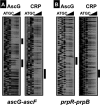Participation of regulator AscG of the beta-glucoside utilization operon in regulation of the propionate catabolism operon
- PMID: 19633077
- PMCID: PMC2747900
- DOI: 10.1128/JB.00663-09
Participation of regulator AscG of the beta-glucoside utilization operon in regulation of the propionate catabolism operon
Abstract
The asc operon of Escherichia coli is one of the cryptic genetic systems for beta-D-galactoside utilization as a carbon source. The ascFB genes for beta-D-galactoside transport and catabolism are repressed by the AscG regulator. After genomic SELEX screening, AscG was found to recognize and bind the consensus palindromic sequence TGAAACC-GGTTTCA. AscG binding was detected at two sites upstream of the ascFB promoter and at three sites upstream of the prpBC operon for propionate catabolism. In an ascG-disrupted mutant, transcription of ascFB was enhanced, in agreement with the repressor model of AscG. This repression was indicated to be due to interference of binding of cyclic AMP-CRP to the CRP box, which overlaps with the AscG-binding site 1, as well as binding of RNA polymerase to the promoter. Under conditions of steady-state E. coli growth in a rich medium, the intracellular level of AscG stayed constant at a level supposedly leading to tight repression of the ascFB operon. The level of prpR, encoding the activator of prpBCDE, was also increased in the absence of AscG, indicating the involvement of AscG in repression of prpR. Taken together, these data suggest a metabolic link through interplay between the asc and prp operons.
Figures








Similar articles
-
Nucleotide sequence, function, activation, and evolution of the cryptic asc operon of Escherichia coli K12.Mol Biol Evol. 1992 Jul;9(4):688-706. doi: 10.1093/oxfordjournals.molbev.a040753. Mol Biol Evol. 1992. PMID: 1630307
-
Catabolite repression of the propionate catabolic genes in Escherichia coli and Salmonella enterica: evidence for involvement of the cyclic AMP receptor protein.J Bacteriol. 2005 Apr;187(8):2793-800. doi: 10.1128/JB.187.8.2793-2800.2005. J Bacteriol. 2005. PMID: 15805526 Free PMC article.
-
Integration of regulatory signals through involvement of multiple global regulators: control of the Escherichia coli gltBDF operon by Lrp, IHF, Crp, and ArgR.BMC Microbiol. 2007 Jan 18;7:2. doi: 10.1186/1471-2180-7-2. BMC Microbiol. 2007. PMID: 17233899 Free PMC article.
-
prpR, ntrA, and ihf functions are required for expression of the prpBCDE operon, encoding enzymes that catabolize propionate in Salmonella enterica serovar typhimurium LT2.J Bacteriol. 2000 Feb;182(4):905-10. doi: 10.1128/JB.182.4.905-910.2000. J Bacteriol. 2000. PMID: 10648513 Free PMC article.
-
Downregulation of the Escherichia coli guaB promoter by upstream-bound cyclic AMP receptor protein.J Bacteriol. 2009 Oct;191(19):6094-104. doi: 10.1128/JB.00672-09. Epub 2009 Jul 24. J Bacteriol. 2009. PMID: 19633076 Free PMC article.
Cited by
-
Indirect repression by Bacillus subtilis CodY via displacement of the activator of the proline utilization operon.J Mol Biol. 2011 Oct 21;413(2):321-36. doi: 10.1016/j.jmb.2011.08.003. Epub 2011 Aug 5. J Mol Biol. 2011. PMID: 21840319 Free PMC article.
-
Quantifying the regulatory role of individual transcription factors in Escherichia coli.Cell Rep. 2021 Nov 9;37(6):109952. doi: 10.1016/j.celrep.2021.109952. Cell Rep. 2021. PMID: 34758318 Free PMC article.
-
Explainability in transformer models for functional genomics.Brief Bioinform. 2021 Sep 2;22(5):bbab060. doi: 10.1093/bib/bbab060. Brief Bioinform. 2021. PMID: 33834200 Free PMC article.
-
Novel insights from hybrid LacI/GalR proteins: family-wide functional attributes and biologically significant variation in transcription repression.Nucleic Acids Res. 2012 Nov;40(21):11139-54. doi: 10.1093/nar/gks806. Epub 2012 Sep 10. Nucleic Acids Res. 2012. PMID: 22965134 Free PMC article.
-
Prokaryotic genome regulation: a revolutionary paradigm.Proc Jpn Acad Ser B Phys Biol Sci. 2012;88(9):485-508. doi: 10.2183/pjab.88.485. Proc Jpn Acad Ser B Phys Biol Sci. 2012. PMID: 23138451 Free PMC article. Review.
References
-
- deCrombrugghe, B., S. Busby, and H. Buc. 1984. Cyclic AMP receptor protein: role in transcription activation. Science 224:831-838. - PubMed
-
- Ellington, A. D., and J. W. Szostak. 1990. In vitro selection of DNA molecules that bind specific ligands. Nature 346:818-822. - PubMed
-
- Hall, B. G., and L. Xu. 1992. Nucleotide sequence, function, activation, and evolution of the cryptic asc operon of Escherichia coli K12. Mol. Biol. Evol. 9:688-706. - PubMed
-
- Hall, B. G., S. Yokoyama, and D. H. Calhoun. 1983. Role of cryptic genes in microbial evolution. Mol. Biol. Evol. 1:109-124. - PubMed
Publication types
MeSH terms
Substances
LinkOut - more resources
Full Text Sources
Other Literature Sources
Molecular Biology Databases
Research Materials
Miscellaneous

